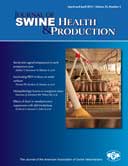Abstract:

Characterization of histopathologic lesions among pigs with overgrown claws
Shelley J. Newman, DVM, DVSc, Diplomate ACVP; Barton W. Rohrbach, VMD, MPH; Mark E. Wilson, MS, PhD; Jerry Torrison, DVM, PhD, Diplomate ACVPM; Sarel van Amstel, BVSc, Diplomate Med Vet, Masters Med Vet, Diplomate ACVIM
Complete article is available online.
PDF version is available online.
Objective: To characterize histologic lesions in pigs with and without claw overgrowth.
Materials and methods: Hindlimb claws from a subset of 24 sows that were part of a larger field study were selected because of claw deformities associated with overgrowth and change in gait. Length measurements were available for 72 lateral or medial rear claws. Claws were examined histologically and the lesions categorized. Overgrowth was defined as a toe growth measuring > 50 mm in length.
Results: Lateral rear claws were most consistently overgrown. However, the distribution and severity of lesions failed to suggest a common etiology for overgrowth. Inflammation, arteriosclerosis, lamellar epithelial changes, phalanx rotation, or combinations of these were not prominent gross or histologic changes.
Implications: The pathogenesis of overgrowth in this collection of claws is unknown, but does not appear to represent primary laminitis in this species. As lameness continues to prompt a significant economic loss due to culling, further studies on claw overgrowth, its effect on motion, and its pathogenesis are warranted.
Keywords: claw, corium, hoof, laminitis
![]() Cite as: Newman SJ, Rohrbach BW, Wilson ME, et al. Characterization of histopathologic lesions among pigs with overgrown claws. J Swine Health Prod 2015;23(2):91-96.
Cite as: Newman SJ, Rohrbach BW, Wilson ME, et al. Characterization of histopathologic lesions among pigs with overgrown claws. J Swine Health Prod 2015;23(2):91-96.
Search the AASV web site for pages with similar keywords.
